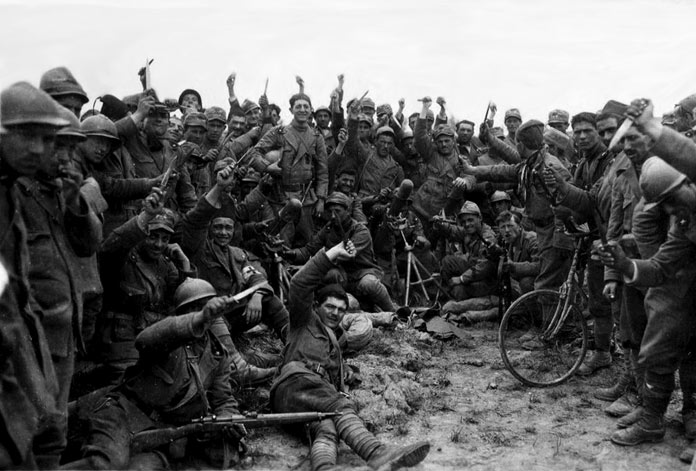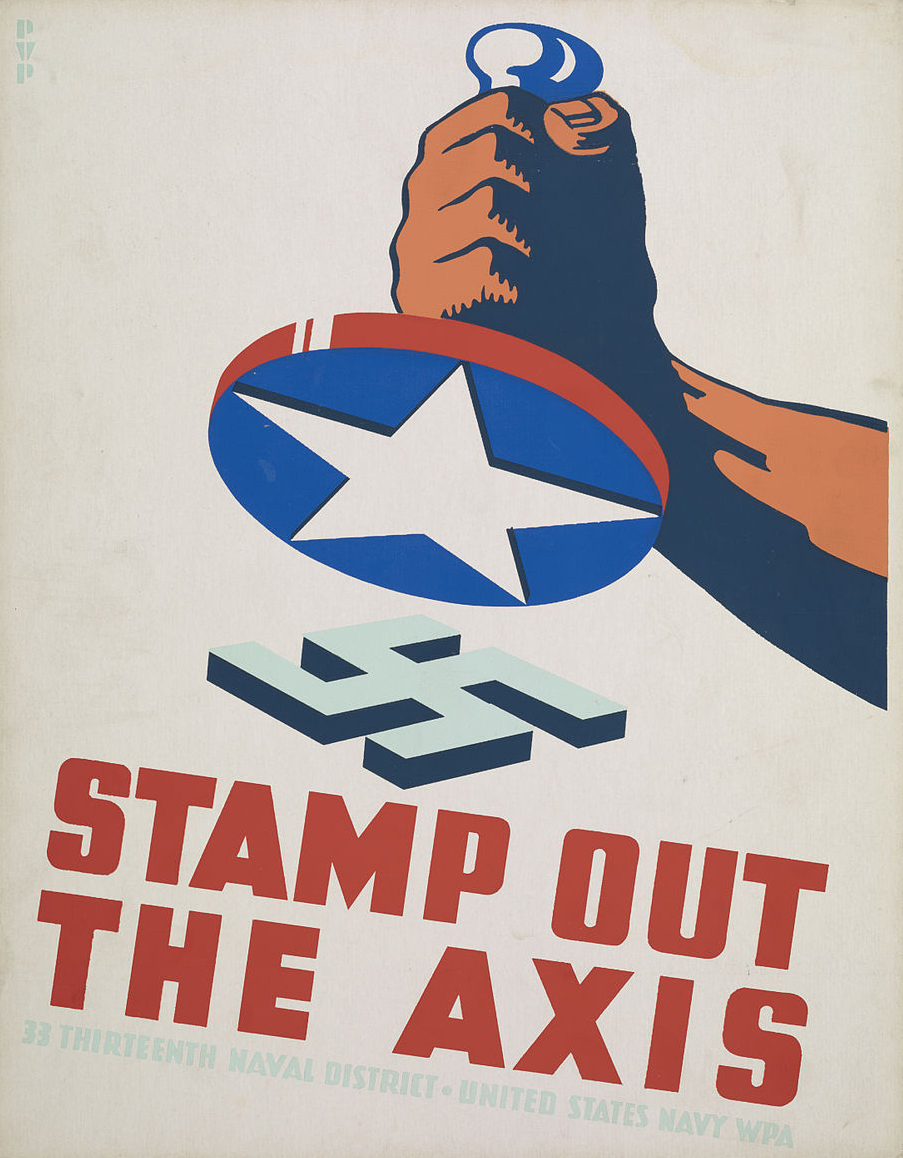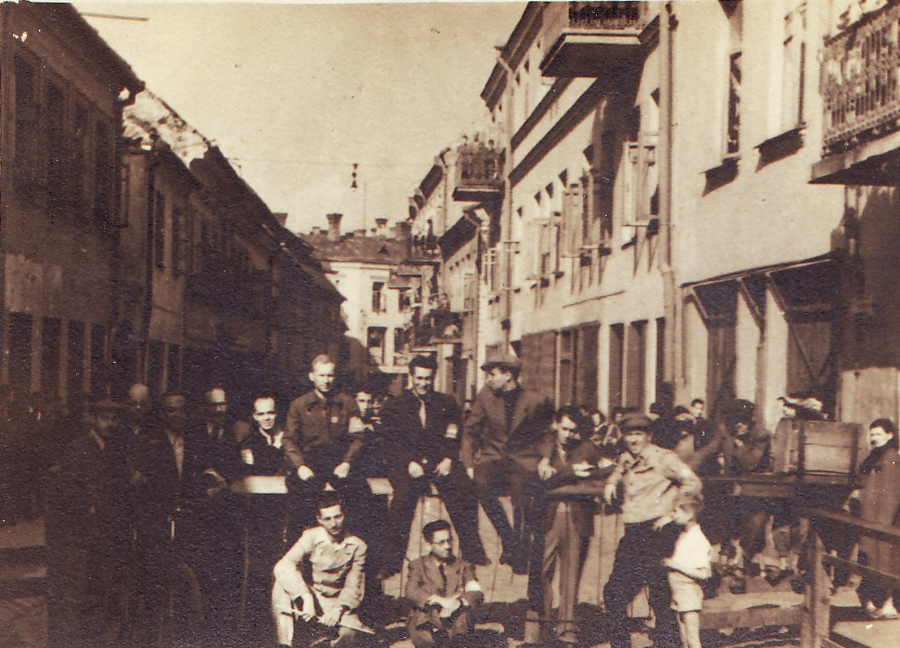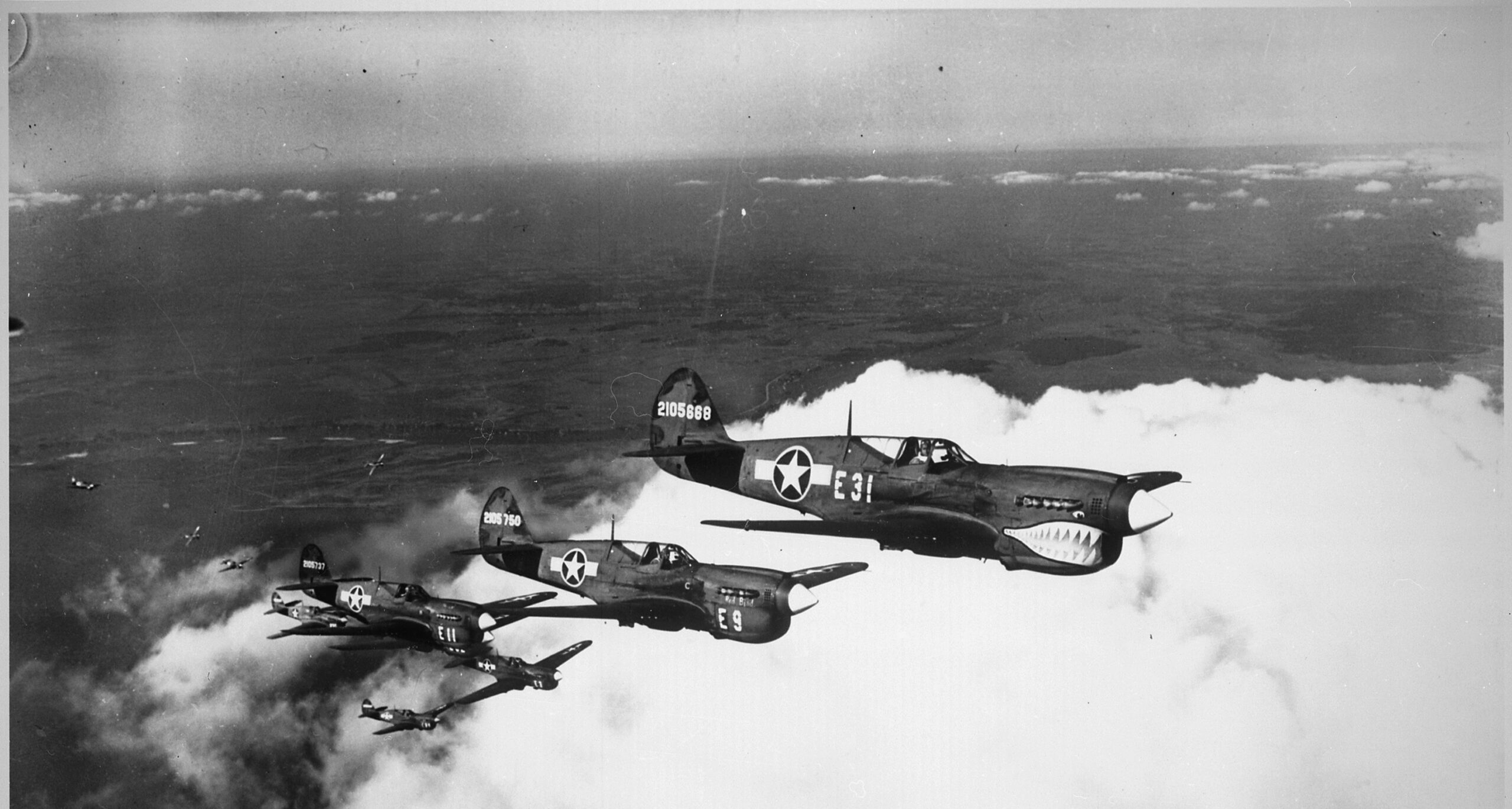
Ashley Cook
November 11, 2024

The Tuskegee Airmen earned the nickname as the Red Tail Angels for fighting fascists in the skies of World War II. They flew hundreds of patrol, escort and attack missions for the Twelfth and Fifteenth Air Forces, and were recorded as the fleet with one of the lowest casualty counts of all of the United States pilots. They were recognizable as a team because of the red tails of their planes, and because they were segregated from all of the other pilots for being primarily African American. As part of the Allied troops who fought for democracy abroad, the Tuskegee Airmen contributed to the defeat of the Axis powers and the end of the Nazi Holocaust. After WWII, they returned home to a segregated country that viewed them as less than human. I am interested in unpacking the complexity of this moment in history to understand the role that the first Black military pilots in the United States had on the development of the anti-fascist political movement, not only internationally, but also here at home.

In Anatomy of Fascism by American Historian Robert Paxton, fascism is described as “the right of the chosen group to dominate others without restraint from any kind of human or divine law”. This type of totalitarianism ultimately prioritizes the needs and desires of one group, often defined by race and ethnicity, over the rest of humanity.1 Fascism as a mode of governance began in Italy in 1921 with Mussolini’s policy of Italianization. In an effort to cleanse the country of non-Italian blood, the Slavic and Croatian people were targeted in an act of cultural genocide. Their language and schools were banned, and they were made to change their names. Arditi del Popolo, known in English as “The People’s Daring Ones”, formed as the first self-proclaimed anti-fascist militant group to fight Mussolini’s fascist government. They were spied on by secret police, raided and murdered by Italy’s Organization for Vigilance and Repression of Anti-Fascism (OVRA).2 In 1932, an anti-fascist group formed in Germany in response to Nazi anti-Semitism and homophobia. They were called the Roter Frontkämpferbund (RFB), originally formed by German workers who were known for raising the now broadly used “clenched-fist salute” as a symbol of intolerance. This salute was later used by the Black Panther Party, Nelson Mandela and most anti-fascist organizations around the world.3

Whatever kind of gene causes the vicious need to manipulate and control life on Earth seems to be the one that distinguishes the human from the animal. Or maybe it is the one that distinguishes the “civilized” from the “savage”... But contrary to popular belief regarding the meaning of these two terms, historically the brutality of war and genocide manifest in the name of “civility”. Contemporary attempts to “fight terrorism” by invading and occupying foreign countries is only the most current demonstration of dominance over the other.4 I mean, it goes without saying that almost every culture that the United States government has chosen to tyrannize has been made up of non-white or non-Christian people in order to “protect our freedom” and “promote just peace.”5 These campaigns of violence are packaged neatly inside concepts of safety in likeness, ultimately establishing diversity as the antithesis to preservation. Propelled by literature like Primitive Culture (1871)6 by Edward Burnett Tylor, or Inquiries into Human Faculty and Its Development (1883)7 by Francis Galton, the ongoing crusade to establish humanness as a scale based on proximity to Eurocentric ideals has wreaked havoc both domestically and overseas. And it is clear that when left unchallenged, this draconian infrastructure of hierarchies always expands to tolerate fewer and fewer, with even its disciples facing their own elimination, eventually.

The story of the Tuskegee Airmen is inspiring, but like any chapter from the history of Civil Rights, its genesis is weaved with disturbing information. You may want to be cautious when reading this piece as it touches on historical realities that may cause distress. You see, although the term “race” was used by Europeans before the 1600s simply to identify kinship or group connection, its meaning transformed during the European Enlightenment in order to justify the colonization of foreign land and the enslavement of people from Africa.8 Starting in the early 17th century, philosophers and naturalists from Europe started to categorize and govern their societies based on the belief that “white” people were inherently smarter, more capable and more human than nonwhite people. (This was an idea that was unheard of before the mid-1600s).9 So, when these “elites” landed on American soil, their newly established scientific methods provided them with measurable reason to classify Native Americans as “savage”, Africans as “subhuman”, and rationalize any form of dispossession, marginalization and exploitation as a natural consequence of inferiority. While these practices were upheld by European colonies around the world, they were particularly impactful on the North American continent. The United States of America as it is today would literally not exist without the invention of race as an applied value system. It became the foundational anthem of the “New World” pioneers, and is now historically documented as the blueprint for subsequent movements of oppression and persecution, including eugenics (1883-now), the Holocaust (1941-1945), and Apartheid (1948-early 1990s).

The early 1900s were a difficult time to be alive for anyone who wasn’t an able-bodied, straight, cisgender, Christian man. By that time, white supremacy had been a widespread belief for almost 300 years. This worldview was perpetuated further by eugenics, which is the practice of sterilization, segregation, exclusion and even euthanization of people of color, as well as members of the disabled and LGBTQ+ communities. Eugenics caught on as a global movement to “improve the human race through various forms of governmental intervention”10 when American biologist Charles Davenport founded the Eugenics Record Office at Cold Spring Harbor Laboratory in New York in 1910. His studies on genetic inheritance in humans were published in scientific journals and taught in universities around the world, eventually being incorporated into fascist manifestos. Of course, it is known that one of the first things that Hitler did after being elected as the Chancellor of Germany was to pass the Law for the Prevention of Hereditarily Diseased Offspring (Gesetz zur Verhütung erbkranken Nachwuchses) in July 1933. “The Nazis, when proposing their own sterilization program, specifically noted the ‘success of sterilization laws in California’ documented most notably by the American eugenicist P.B. Popenoe.”11

By the time eugenics created a scientific structure for racism, Jim Crow Laws, first written in 1877, had already been in place for 33 years. They originated from the Black Codes that governed the autonomy of African Americans after the Civil War. The systemization of economic, educational and social disadvantages for Black people in the U.S. provided the structure for Nazi lawyers to draft and implement in Germany. Race laws in the US inspired two major pieces of legislation: The Reich Citizenship Law, and the Law for the Protection of German Blood and German Honor.12 Known primarily as the Nuremberg Laws, they were established in 1935 to put into motion the persecution of the Jewish people. The anti-fascist propaganda spread by the American government after entering into WWII garnered support from American citizens, but it was obviously not an authentic sentiment. Especially when, in the early 1930s, American eugenicists actually welcomed Nazi ideas about racial purity, and republished their literature and propaganda. On top of that, “American aviator Charles Lindbergh even accepted a swastika medal from the Nazi Party in 1938”.13 It was only after the attack on Pearl Harbor that the US expressed opposition to the Nazi party and inducted 10 million men between the ages of 18 and 64, regardless of race, to fight as a united front in a segregated military.
Before 1939, the roles that African American soldiers could hold within the military were restricted based on the notion that Black people did not have the problem-solving skills to perform effectively in more complex strategy and combat situations. It is interesting that the military believed that “the Black man cannot control himself in the face of danger to the extent the white man can”,14 when danger haunted the lives of Black people in America on a daily basis for the past three centuries. Strategies for safety were literally built into their culture with elements like The Negro Motorist Greenbook, also known as “the bible of Black travel during Jim Crow.”15

Anyways, the government had pressure from many angles for discrimination in the military. Black organizations like the NAACP, as well as Black media outlets, publicly criticized the racist practices of the military, but change truly happened when Yancey Williams, a Howard University student who wanted to become a pilot, filed a lawsuit against the War Department for being denied entry into the program. Williams won this fight based on the “separate but equal” doctrine,16 leading to Secretary of the Army Henry L. Stimson’s authorization for the formation of the Black Pursuit Squadron in January 1941. This was followed by President Roosevelt’s activation of the all-Black WWII fighter squadron and the Tuskegee Airmen Experiment at the Tuskegee Institute in Alabama in March of 1941.17 One year later, in March of 1942, the first Tuskegee Airmen graduated from the pilot training program. Their names were Benjamin O. Davis, Jr. (Tuskegee, AL), George Roberts (Fairmont, WV), Charles Debow, Jr. (Indianapolis, IN), Mac Ross (Dayton, OH) and Lemuel Custis (Hartford, CT). The program went on to train 16,000 more Tuskegee Airmen; out of that number, 996 of them became pilots and 352 were deployed to fight in the war.18


Of the 996 pilots to graduate and become Tuskegee Airmen, 33 were from Detroit.19 Like the American South, racism in Northern states limited and threatened the professional, social and personal lives of African American people. The 1940s in Michigan mirrored Nazi Germany in cases of housing and anti-miscegenation laws. To be specific, starting in 1846, it was illegal in Michigan for Black people to marry or have intimate relationships with white people (this law was not annulled until 1967).20 The Nazis translated this into their own social structures, not allowing Jews and Aryans to marry; however, it is known that America was upholding the most severe approach to this type of law. “Rather than adopting a ‘one-drop’ rule like the US, the Nazis decreed that a Jewish person was anyone who had three or more Jewish grandparents.”21 Populations that were considered to be legally unworthy of equal rights, determined by these rules, experienced movement restrictions and redlining. Between the 1930s and ‘50s, the federal government worked with the Detroit Police Department, local governments, banks and other private institutions to maintain racially segregated neighborhoods. At that time, most of Detroit’s African American population was restricted to Black Bottom and Paradise Valley. Hostility towards Black Detroiters also resulted in violence, like Detroit’s 1943 race riot caused by white mobs and police officers who attacked and killed Black residents.22 Meanwhile in Nazi-occupied territories, Jewish people were concentrated into their own separate neighborhoods known as “Jewish ghettos”, with the first established in 1939 in Poland.23 Jews had also experienced frequent violence from police and non-Jewish citizens.


Many people wondered why America’s Black citizens felt so compelled to fight for the United States, a country that has done nothing but enslave, ridicule, murder, and oppress them. Their responses were overwhelmingly hopeful. These African Americans saw the United States as their home, and they believed that fighting for the US in WWII was a unique opportunity to prove their patriotism, challenge stereotypes and fight for a kind of freedom abroad that they were also fighting for at home. Despite facing challenges with racism within the military, the Tuskegee Airmen demonstrated having valuable skills that they gained from the intense training program in Alabama. They flew P-40 and P-39 airplanes in North Africa for the Twelfth Air Force before being assigned to escort B-17 and B-24 heavy bombers over Southern Italy. Their uniforms were on par with other fighters, and they had unique patches to represent their fleet. “As escorts flying P-47s and later P-51s, the Tuskegee Airmen were responsible for protecting larger bombers from German fighter planes. They flew more than 15,000 missions between May 1943 and June 1945, often being requested as escorts because of their success.”24 By the end of World War II, the Red Tails earned one Silver Star, eight Purple Hearts, fourteen Bronze Stars, 744 Air Medals, three Distinguished Unit Citations, and 94 Distinguished Flying Cross Medals.25

World War II ended on September 2, 1945. After risking their lives fighting for freedom abroad, the Tuskegee Airmen arrived back home to a world where Jim Crow continued to restrict the freedom of Black American citizens. It was noted that even “German prisoners of war were treated better than Black Americans.”26 Basic reasoning would consider the fact that segregation still existed after the “war on fascism” was ridiculous, but the sad reality is that it did. In 1945 at the Freeman Field in Seymour, Indiana, the Officers Clubs were segregated and all African American officers were ordered to sign a document agreeing to this demand. In a motion later known as The Freeman Field Mutiny, over 100 Black officers refused to sign the document and were also court-martialed for trying to enter the white officers’ club. Three of the Tuskegee Airmen were then placed on trial, and one of them, Lt. Roger Terry was actually found guilty and dishonorably discharged from the military.27 There were various reports of aggression and violence towards Black military members and veterans after WWII. On February 12, 1946, African American WWII veteran Isaac Woodard was beaten and binded by South Carolina Police.28 This occurrence was publicly criticized by the NAACP, Black celebrities and even Orson Welles. President Truman himself even became disgusted by the treatment of Black soldiers and veterans across the country, stating that his “stomach turned over when (he) learned that Negro soldiers, just back from overseas, were being dumped out of army trucks in Mississippi and beaten.”29 The president became deeply influenced by these reports of violence, compelling him to undertake civil rights reform, including signing Executive Orders 9980 and 9981 in 1948, which aimed at desegregating the military and the federal workforce.30 The Tuskegee Airmen and other Black military personnel continued to fight into the ‘60s for a fully desegregated country, and finally, in 1964, Jim Crow was outlawed with the signing of the Civil Rights Act by Lyndon B. Johnson. This was followed by the Voting Rights Act in 1965, and the Fair Housing Act in 1968.
The practice of “othering” is required for totalitarianism to exist because such regimes are founded on strictly established identities that can only be formed through a testimony of what, or who, they are not. Mass mind control has been initiated historically through blanket statements that negatively frame entire groups of people. Derogatory language leads to exclusion, which leads to fear of the excluded, hatred for the excluded and violence toward the excluded. The Tusekegee Airmen are recognized these days as pioneers of the Civil Rights Movement in the United States for breaking barriers within the military, challenging fascism abroad, and then returning to challenge fascism again at home. The fight for their own equal rights has influenced revolutionary efforts of marginalized communities around the world, which has, in the past 100 years, weaved a complex and radical network founded on a faith in the power of uniqueness.
Happy Veteran’s Day to everyone who has ever fought this war.
Edited by Kellen MacGregor
1. Magazine, S. (2020, June 24). A Brief History of Anti-Fascism. Smithsonian.com. Link.
2. Magazine, S, A Brief History of Anti-Fascism.
3. Magazine, S, A Brief History of Anti-Fascism.
4. “Othering | Definition in the Cambridge English Dictionary.” Dictionary.cambridge.org. Accessed November 7, 2024. Link.
5. National Archives and Records Administration. Accessed November 6, 2024. Link.
6. Encyclopædia Britannica, inc. (2024, September 25). Primitive culture. Encyclopædia Britannica. Link.
7. Encyclopædia Britannica, inc. (n.d.). Applied Psychology. Encyclopædia Britannica. Link.
8. Smithsonian. (n.d.). Historical Foundations of Race | National Museum of African American History and Culture. nmaahc.si.edu. Link.
9. Smithsonian, Historical Foundations of Race.
10. Farber, S. A. (2008, December). U.S. Scientists’ Role in the Eugenics Movement (1907-1939): A Contemporary Biologist’s Perspective. Zebrafish. Link.
11. Farber, U.S. Scientists’ Role.
12. A&E Television Networks. (n.d.). How the Nazis were Inspired by Jim Crow. History.com. Link.
13. A&E, How the Nazis were inspired by Jim Crow.
14. Laura Skitt 28th February 2024 at 1:14pm. (n.d.). Tuskegee Airmen: The Pioneering Black Pilots Whose Excellence Helped Desegregate the US Military. Forces News.Link.
15. The Negro Motorist Green-Book. The Library of Congress. (n.d.). Link.
16. Kay, L. (2022, January 10). Yancey Williams. CAF RISE ABOVE. Link.
17. Public Broadcasting Service. (n.d.). The Tuskegee Airmen: Facts, Members, Planes & WWII Story. PBS. Link.
18. Public Broadcasting Service. (n.d.-a). The Tuskegee Airmen: Facts, members, Planes & WWII Story. PBS.Link.
19. Tuskegee Airmen Pilot Listing. Tuskegee University. (n.d.). Link.
20. Race & Ethnicity in Metropolitan Detroit Timeline. Youth Civil Rights. (n.d.). Link.
21. A&E Television Networks. (n.d.). How the Nazis were Inspired by Jim Crow. History.com. Link.
22. Civil Rights and Police Brutality, 1957-1963 · Detroit under fire: Police violence, crime politics, and the struggle for racial justice in the Civil Rights Era · HistoryLabs Omeka S. (n.d.). Link.
23. Kevindupuy. (2023, October 18). Nazi Germany and the Establishment of Ghettos. The National WWII Museum | New Orleans. Link.
24. Tuskegee Airmen. nationalww2museum.org.(n.d.).Link.
25. Zach. (2022, August 26). USAFA Celebrates Tuskegee Airmen. United States Air Force Academy. Link.
26. Taub, M. (2020, July 28). In WWII, the U.S. Treated Nazi POWs Better than Black Troops. Time. Link.
27. A&E Television Networks. (n.d.-b). How Tuskegee Airmen Fought Military Segregation with Nonviolent Action. History.com. Link.
28. Madeo. (n.d.). Feb. 12, 1946: Police Chief in SC Beats Black Veteran Isaac Woodard, Leaving Him Blind. calendar.eji.org. Link.
29. The Long Blue Line: Part III “when I say Americans, I mean all Americans!”. United States Coast Guard. (2023, July 26). Link.
30. National Archives and Records Administration. (n.d.). Executive order 9981: Desegregation of the Armed Forces (1948.) National Archives and Records Administration. Link.